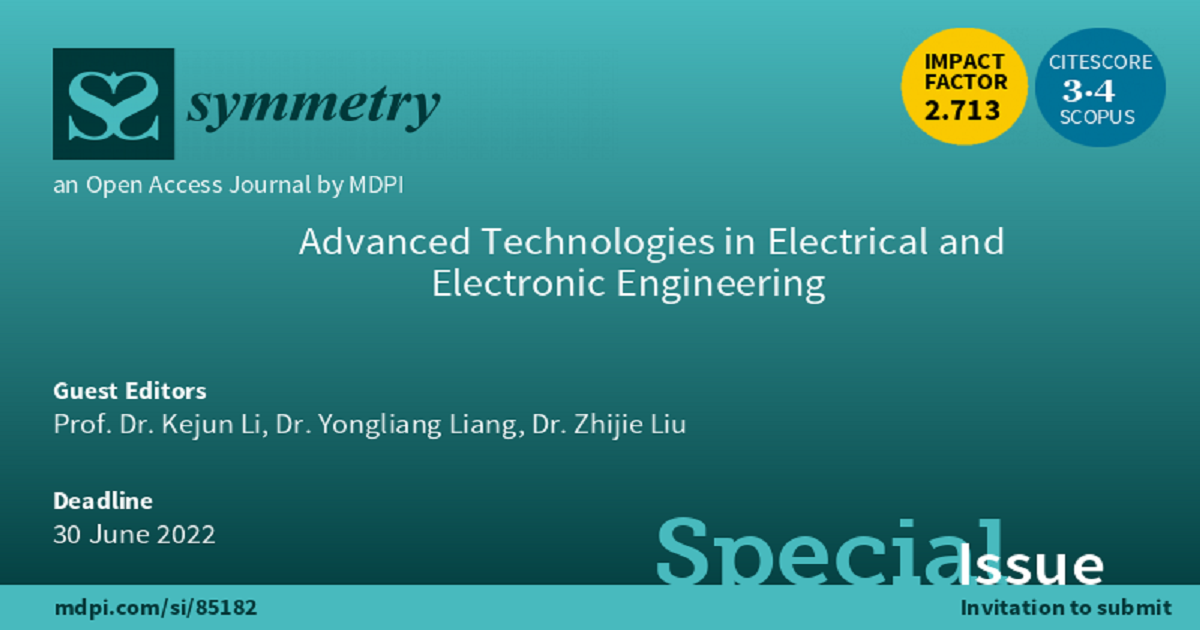Advanced Technologies in Electrical and Electronic Engineering
A special issue of Symmetry (ISSN 2073-8994). This special issue belongs to the section "Engineering and Materials".
Deadline for manuscript submissions: closed (30 November 2021) | Viewed by 22798

Special Issue Editors
Interests: renewable energy integration and utilization; flexible DC transmission system; DC grid; smart distribution network; integrated energy system
Special Issues, Collections and Topics in MDPI journals
Interests: fault analysis and identification of smart distribution networks; protection of active distribution networks; power transformer condition assessment; optimal dispatch of integrated energy system
Special Issues, Collections and Topics in MDPI journals
Interests: renewable energy integration; high-power converters; mathematical modelling; HVDC technology
Special Issues, Collections and Topics in MDPI journals
Special Issue Information
Dear Colleagues,
The electrical power system can be regarded as a comprehensive symmetrical system of power supply and power consumption, which is facing numerous unprecedented threats and challenges from urgent low-carbon requirement, uncertain renewable power integration, severe natural disasters, energy costs climb, and so forth. In particular, the increasing penetration of distributed energy resources along with converters strengthens the asymmetry problem of distribution network. To achieve an affordable, clean, safe, stable, and resilient power supply and to address asymmetrical problems, new technologies are presented, which include but are not limited to the integrated energy system (IES), smart distribution network (SDN), multilevel high power converter (MHPC), advanced power system protection technology (APSP), direct current transmission and distribution techonology (DCTD), panoramic situation awareness (PSA), and high-voltage insulation technology (HVI). The planned issue of Symmetry seeks to show the great significance of expressing new ideas and conducting research. In the opinion of the Guest Editors, there are many potential possibilities for the application of new techonologies to solve the problems faced by conventional electrical systems. This Special Issue is intended to encourage scholars to submit their research in this interesting field of study.
Prof. Dr. Kejun Li
Dr. Yongliang Liang
Dr. Zhijie Liu
Guest Editors
Manuscript Submission Information
Manuscripts should be submitted online at www.mdpi.com by registering and logging in to this website. Once you are registered, click here to go to the submission form. Manuscripts can be submitted until the deadline. All submissions that pass pre-check are peer-reviewed. Accepted papers will be published continuously in the journal (as soon as accepted) and will be listed together on the special issue website. Research articles, review articles as well as short communications are invited. For planned papers, a title and short abstract (about 100 words) can be sent to the Editorial Office for announcement on this website.
Submitted manuscripts should not have been published previously, nor be under consideration for publication elsewhere (except conference proceedings papers). All manuscripts are thoroughly refereed through a single-blind peer-review process. A guide for authors and other relevant information for submission of manuscripts is available on the Instructions for Authors page. Symmetry is an international peer-reviewed open access monthly journal published by MDPI.
Please visit the Instructions for Authors page before submitting a manuscript. The Article Processing Charge (APC) for publication in this open access journal is 2400 CHF (Swiss Francs). Submitted papers should be well formatted and use good English. Authors may use MDPI's English editing service prior to publication or during author revisions.
Keywords
- Integrated energy system
- DC transmission and distribution techonology
- Multilevel high-power converter
- Smart distribution network
- Advanced power system protection technology
- Panoramic situation awareness
- High-voltage insulation technology
- Low-carbon technology
Benefits of Publishing in a Special Issue
- Ease of navigation: Grouping papers by topic helps scholars navigate broad scope journals more efficiently.
- Greater discoverability: Special Issues support the reach and impact of scientific research. Articles in Special Issues are more discoverable and cited more frequently.
- Expansion of research network: Special Issues facilitate connections among authors, fostering scientific collaborations.
- External promotion: Articles in Special Issues are often promoted through the journal's social media, increasing their visibility.
- e-Book format: Special Issues with more than 10 articles can be published as dedicated e-books, ensuring wide and rapid dissemination.
Further information on MDPI's Special Issue polices can be found here.






